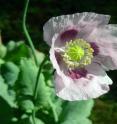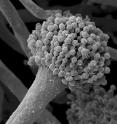Fungi -- a promising source of chemical diversity
The fungus Aspergillus fumigatus produces a group of previously unknown natural products. With reference to plant isoquinoline alkaloids, these substances have been named fumisoquins. Researchers from Jena (Germany) discovered the novel substances together with their American colleagues while studying the fungal genome. The family of isoquinoline alkaloids contains many pharmacologically active molecules. This study, which has just been published in Nature Chemical Biology, shows that fungi and plants developed biosynthetic pathways for these complex molecules independently of each other. These findings make Aspergillus an interesting target for the discovery of novel drugs and their biotechnological production. A large number of drugs used today originate from nature. Most of these molecules, which can be found with or without synthetic modifications and exert their beneficial effect on human health, are derived from microorganisms or plants. Thus, it is of great interest to discover novel active compounds in nature and use them for the treatment of diseases.
One well-known group of plant metabolites are the isoquinoline alkaloids. Today more than 2,500 different types are known and they are mainly found in poppy and barberry plants. Famous examples include the painkiller morphine or the cough remedy codein.
Together with colleagues from the US, scientists in the labs of Dirk Hoffmeister and Axel Brakhage at the Friedrich Schiller University in Jena found out that fungi synthesize certain natural products in a very similar way to plants. They analyzed the genome of the common mold Aspergillus and discovered a small cluster of genes whose function was previously unknown. Comparing these genetic sequences with known data implied that they might be responsible for the synthesis of novel natural products.
By manipulating the genetic sequences, characterizing the resulting metabolites and using radioactive labeling experiments it was possible to elucidate the structure of the novel molecules and to unravel the detailed biosynthetic pathways. The researchers discovered a new linkage mechanism for carbon atoms which had never been seen before in fungi. The whole fumisoquin biosynthetic pathway appears to be a combination of plant biosynthetic principles and the non-ribosomal peptide synthetases commonly found in fungi.
Axel Brakhage, university professor and head of the Leibniz Institute for Natural Product Research and Infection Biology, explains: "Fungi and plants diverged early on during evolution. The newly discovered fumisoquin synthesis pathway shows that there was a parallel development for the production of isoquinoline alkaloid compounds in both groups of organisms. This opens up new roads for combinatorial biotechnology in order to advance the search for novel active compounds and thus to develop urgently needed new drugs."
Dirk Hoffmeister, professor at the Institute for Pharmacy at Friedrich Schiller University, is pleased with the joint efforts: "The published study is a great example of the tight collaboration between the university and the Leibniz Institute for Natural Product Research and Infection Biology - Hans Knöll Institute - and our American partners. Good research does not know any borders."
The international scientific association "Faculty of 1000" included this publication in their hit list of seminal research results.
Source: Friedrich-Schiller-Universitaet Jena
Other sources
- Fungi: Promising source of chemical diversityfrom Science DailyMon, 30 May 2016, 2:01:03 UTC
- Fungi -- a Promising Source of Chemical Diversityfrom Newswise - ScinewsFri, 27 May 2016, 20:50:53 UTC
- Molds and plants share similar ways in alkaloid biosynthesisfrom Science DailyFri, 27 May 2016, 18:00:57 UTC
- Moulds and plants share similar ways in alkaloid biosynthesisfrom PhysorgFri, 27 May 2016, 13:31:03 UTC

